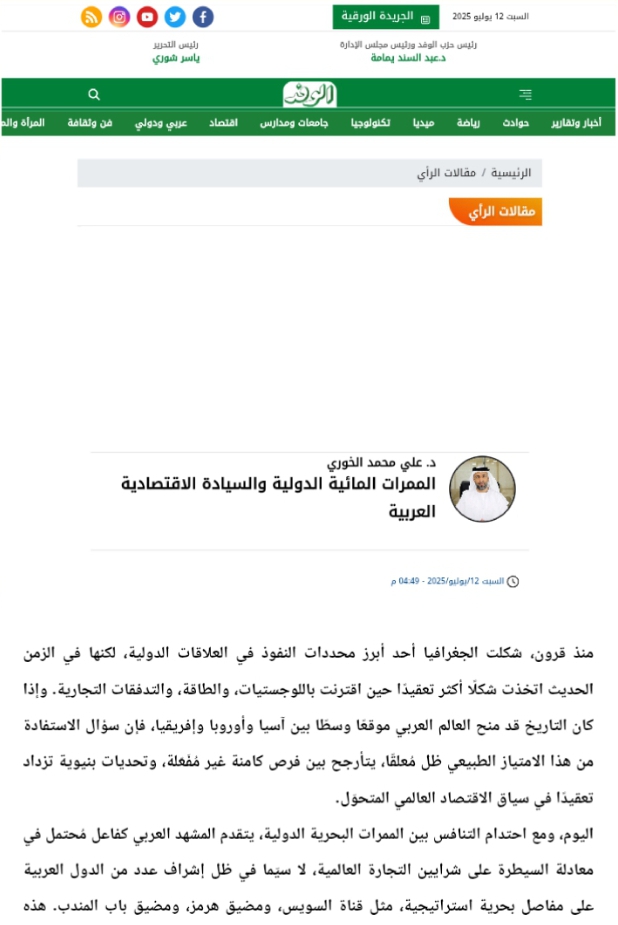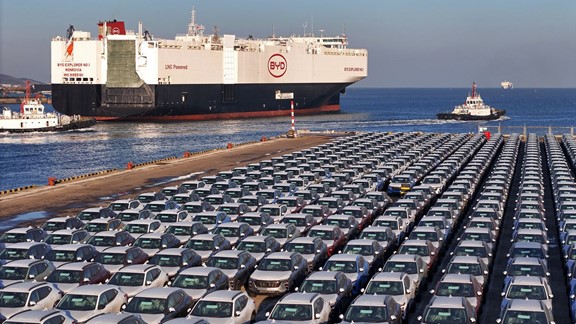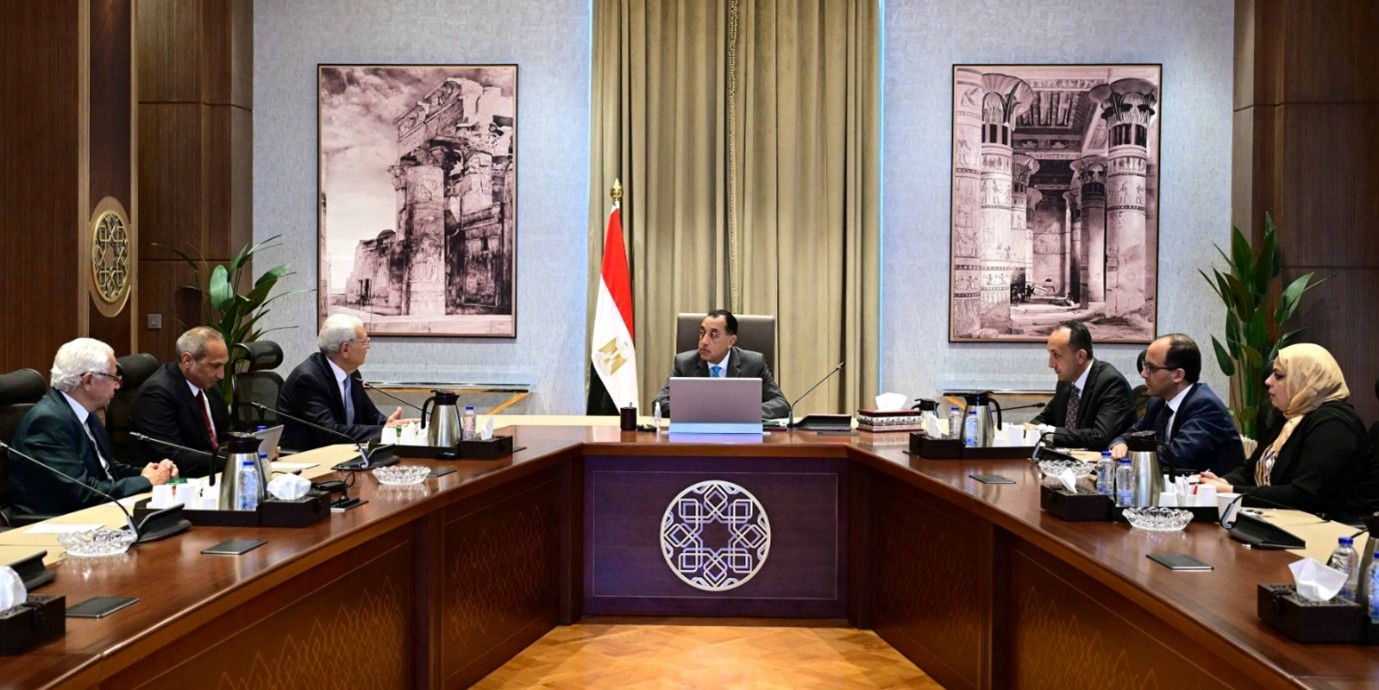Cairo
Source: Al-Wafd Newspaper
Prof. Dr. Ali Mohamed Al-Khouri
For centuries, geography has been one of the most prominent determinants of influence in international relations, but in modern times, it has taken on a more complex form when coupled with logistics, energy, and trade flows. While history has granted the Arab world a central position between Asia, Europe, and Africa, the question of how to capitalize on this natural advantage has remained unrealized, oscillating between latent, unfulfilled opportunities and increasingly complex structural challenges in the context of a transforming global economy.
Today, with competition intensifying across international maritime corridors, the Arab world is emerging as a potential player in the equation for control of global trade arteries, particularly given that several Arab countries control strategic maritime chokepoints, such as the Suez Canal, the Strait of Hormuz, and the Bab al-Mandab Strait. These waterways are not merely waterways; they are pivotal points for the future of the region’s political economy.
The Suez Canal, for example, has transformed from a 19th-century excavation project imposed by European expansionist interests into a source of sovereign income. In 2023, the canal’s annual revenues reached nearly $9.4 billion, according to data from the Suez Canal Authority, making it one of the most profitable shipping canals in the world. But the story doesn’t stop there. What applies to Egypt could potentially extend to the countries bordering the Strait of Hormuz or Bab el-Mandeb, if these waterways were rethought as comprehensive economic platforms, rather than mere transit points.
These corridors enable Arab countries to become vital links in global supply chains, going beyond mere transit to hosting logistics and warehousing activities, establishing industrial zones focused on industries related to transit trade, and even re-export and assembly. With many Arab economies seeking to decouple their relative dependence on oil revenues, investing in infrastructure related to navigation and maritime transport appears to be a strategic choice that takes into account sustainability and aligns with structural shifts in the pattern of global trade.
Arab countries possess vast financial tools through their sovereign wealth funds, which manage trillions of dollars, from Riyadh to Abu Dhabi to Doha and Kuwait. These resources could be used not to finance deficits, but rather to establish integrated networks of smart ports, navigation systems, logistics centers, regional shipping companies, and shipbuilding and maintenance companies, transforming these corridors from transit corridors to decision-making centers.
The real opportunity lies in transforming the region from a transit zone to a hub. This requires not only financial investments, but also a vision and political will that believes in the concept of regional integration and can agree on cross-border strategic projects, especially in light of the intense international competition to reshape the geography of maritime corridors, following the Russian-Ukrainian war and escalating tensions in the South China Sea.
But the path is not without challenges. The state of Arab political fragmentation, coupled with the protracted security crises in a number of countries bordering strategic waterways, creates an environment that discourages investment and undermines the region’s credibility as a reliable player on the global maritime trade map. Added to this are the persistence of inefficient bureaucracies, the weakness of the legislative framework related to foreign investment, and the conflict of interests among Arab countries themselves, which have yet to reach an integrated formula that establishes sustainable strategic economic relations.
The challenge is not limited to domestic issues. Arab countries face growing competition from regional ports such as the Port of Piraeus in Greece, in which China is investing as part of the Belt and Road Initiative, and Jebel Ali Port in Dubai, which adopts an advanced model for integrating industrial activities and logistics services.
To overcome these obstacles, investment policies must be adopted based on clarity, transparency, reducing systemic risks, and building sustainable partnerships between the public and private sectors. Infrastructure development also requires a vision that goes beyond quick fixes and embraces long-term planning that takes into account the environmental, digital, and major geopolitical shifts.
In this context, there is a pressing need for a joint Arab project that embraces the re-engineering of the Arab maritime landscape with a unified vision, one that pushes toward building a regional logistics platform through which standards can be unified, data exchanged, talent trained, and smart technologies leveraged. This will create an effective Arab maritime bloc capable of negotiating with major powers from a position of equal partnership, rather than from a position of subordination or silent transit.
Perhaps the current strategic moment, with its escalation in global geo-economic tensions, presents an opportunity for Arabs to reposition themselves at the heart of global maritime trade. When some traditional trade routes are dismantled due to conflict, cost, or complexity, alternative routes are created not only with maps, but also through investment in preparedness, capacity, and location.
Upon deeper contemplation, waterways, in the Arab context, appear to be a test of the will to build and a measure of geography’s ability to transform into an implementable strategic project. However, reliance on location alone is not sufficient to build a sustainable economic position. Geography, however promising it may appear, only gains value if it is integrated within a cohesive institutional framework based on operational efficiency, stable financing structures, and an investment vision capable of interacting with international variables. The real challenge lies not in owning the waterway, but in possessing the ability to utilize it within the network of global interests in a manner that guarantees added value. Those who are slow to build this type of institutional readiness will not be partners in shaping the flow of international trade, but rather subservient to equations determined externally.












